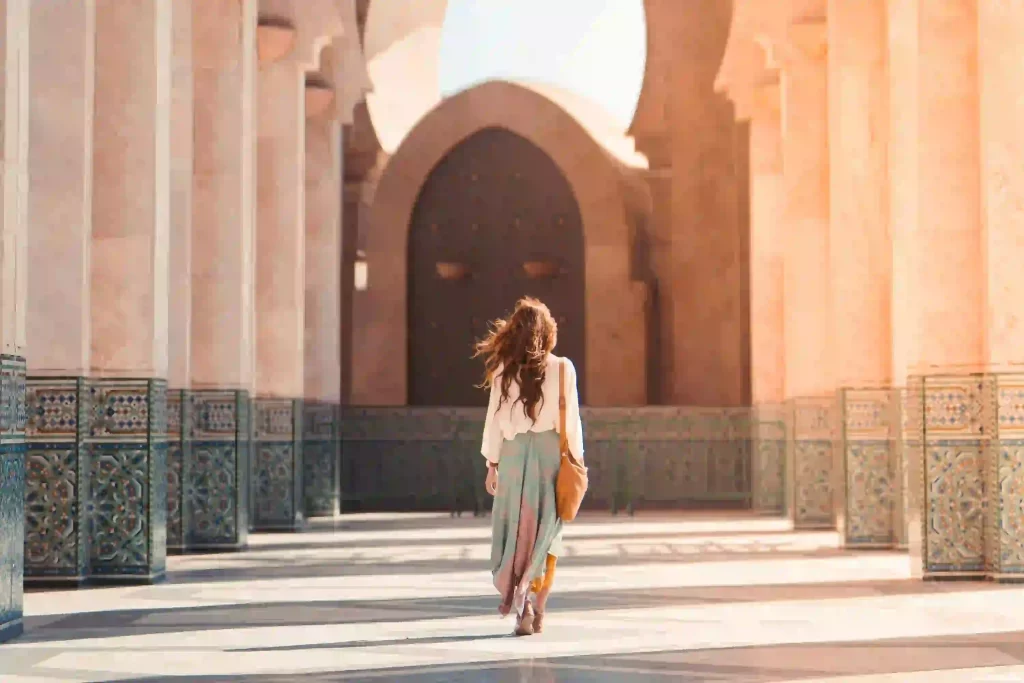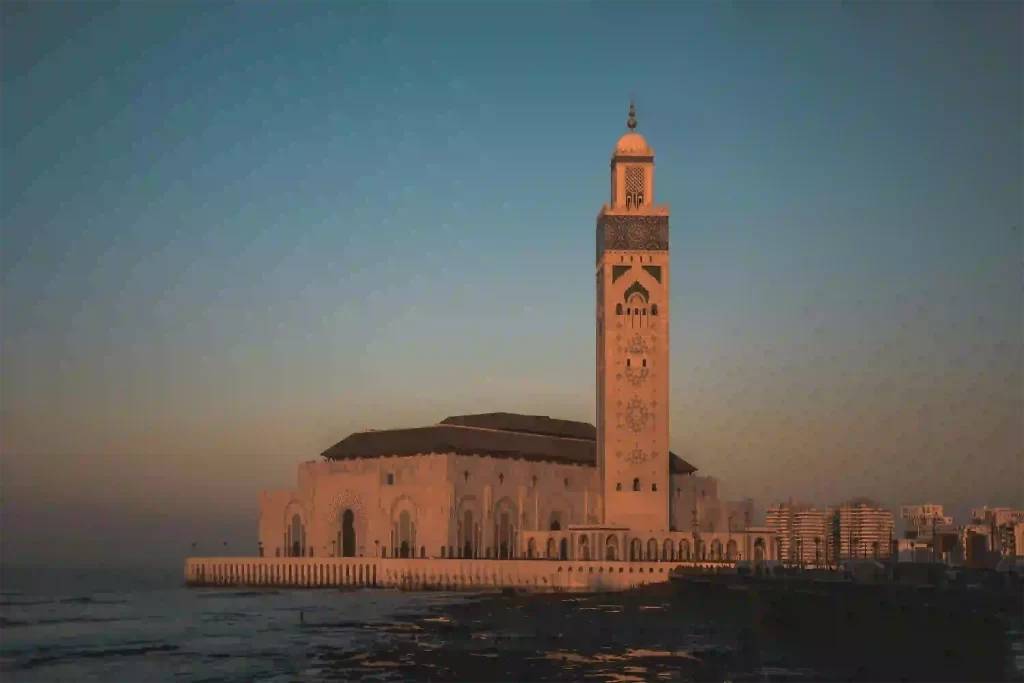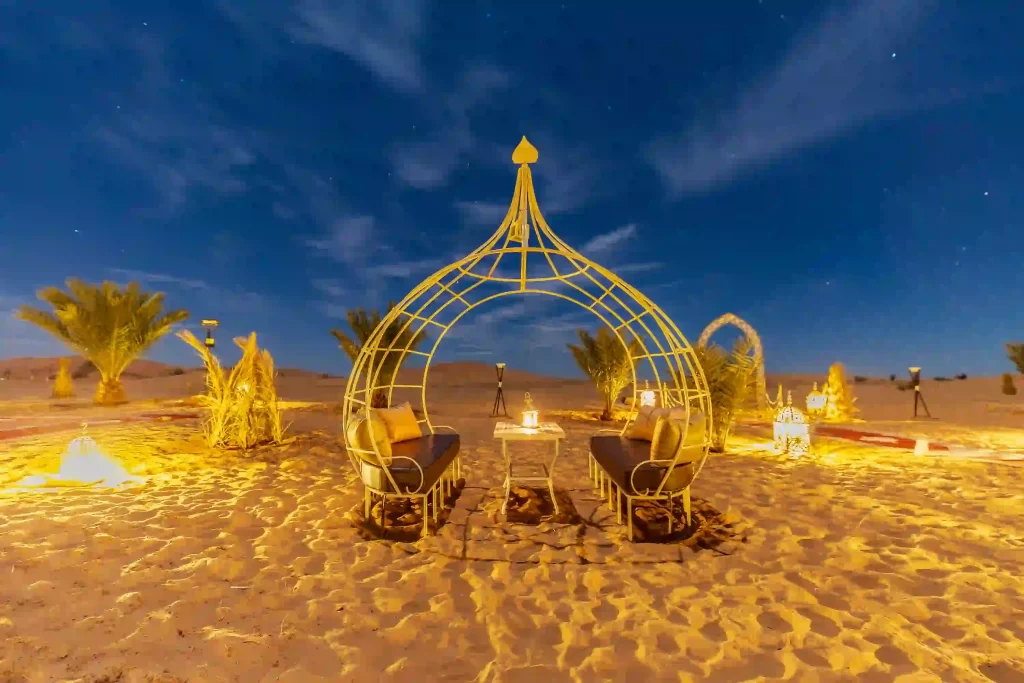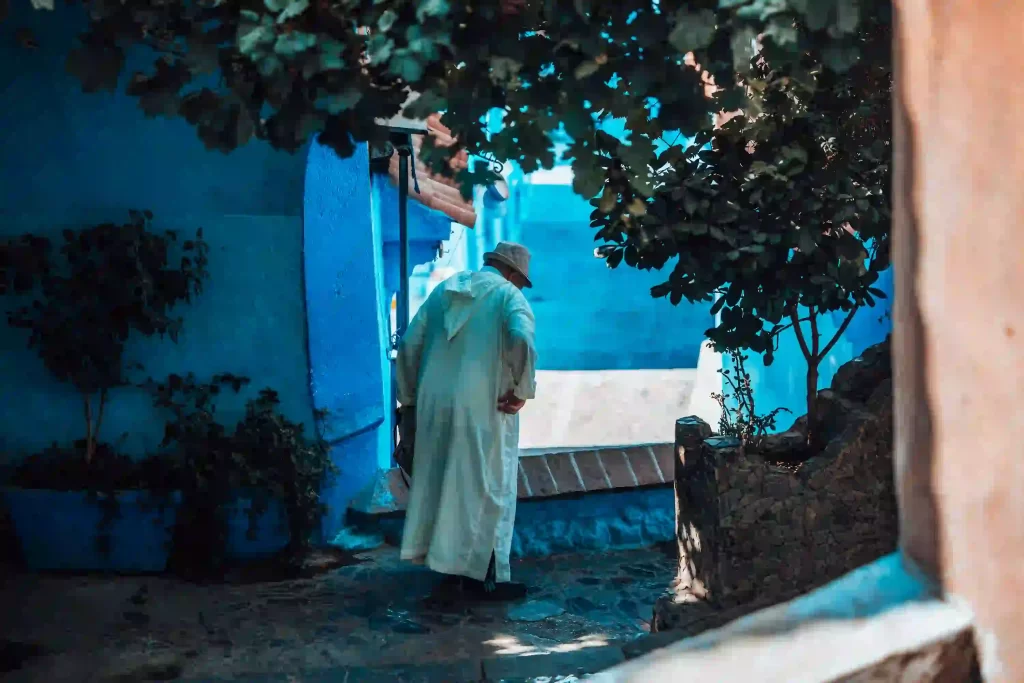12 days Morocco Trip From Marrakech
Embark on a 12-day Moroccan adventure from Marrakech. Explore vibrant city life, coastal beauty in Essaouira, and the majestic Sahara Desert on camelback. Marvel at the Moroccan Argan trees and unwind in the peaceful blue streets of Chefchaouen.
- Starts from 200$
- 12 Days
- From Marakech
Tour criterias
Your Comfort on This Tour
- Relax and unwind in our air-conditioned vehicle boasting spacious seats and ample legroom for a comfortable journey. Scheduled rest stops every few hours ensure you arrive at your destination refreshed and ready to explore.
- Nestled in a charming hotela/riada, enjoy the convenience of private bathrooms and hot water. Daily housekeeping guarantees a fresh and inviting space throughout your stay. Accessible features are available upon request, please inquire for details.
- Immerse yourself in the local culinary scene with our delicious and authentic meals. Vegetarian options are always available to accommodate diverse dietary needs. Enjoy the variety of dining settings, from bustling restaurants to scenic picnic spots.
- Explore at your own pace! We cater to various fitness levels, offering both active adventures and leisurely discoveries. Relax in shaded areas during excursions and enjoy rejuvenating rest breaks, ensuring your comfort every step of the way.
Itinerary
Discover fascinating locales.
Day 1 : arrival day in Marrakech
Depending on when you arrive at the airport in Marrakech, our crew will be ready for you to begin this incredible journey that will go for twelve days while you are with us. The staff will make arrangements to pick you up at the hotel or riad that is often situated inside the walled ancient Medina of Marrakech. The rest of the day will be spent unwinding following your travel to Morocco, which is your second home.
In Marrakech, spend the night.
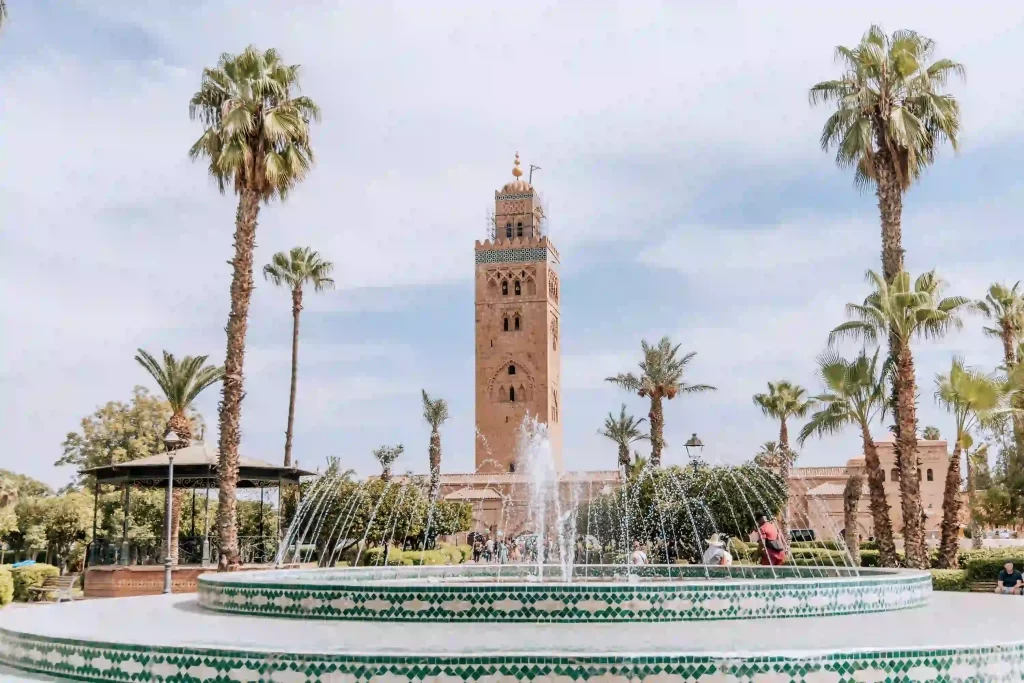
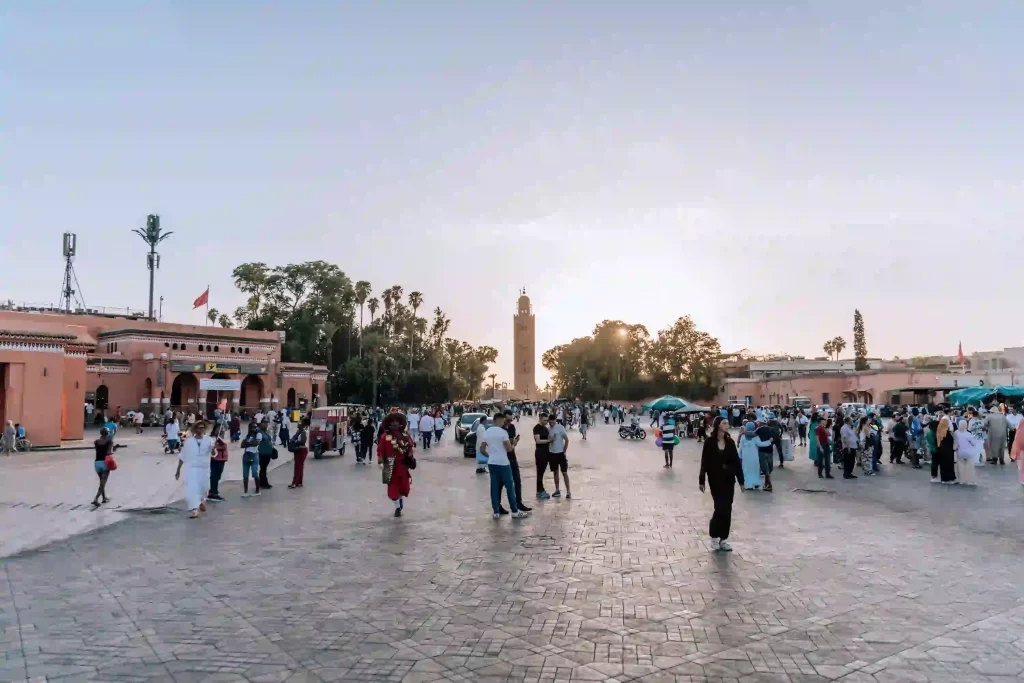
Day 2 : Full day exploring Medina of Marrakech with local guide
On Day 2 of our Moroccan vacation, we spent the day in Marrakech’s bustling Medina, escorted by a local expert who shared his knowledge of the city’s history and culture. The UNESCO World Heritage-listed Medina is Marrakech’s vibrant core, full of souks. Marrakech’s vibrant Jemaa el-Fnaa square was our starting point. Street entertainers, crafters, and merchants sold a range of items and foods in this multicultural area. Traditional music, spices, street cuisine, and booths and businesses make the plaza a sensory feast. Our guide showed us hidden jewels and historical places in the Medina’s twisting lanes. The Saadian Tombs and Bahia Palace, a Moroccan architectural marvel, revealed the city’s royal heritage. Marrakech’s souks, featuring sections for spices, textiles, jewelry, and leatherwork, were a highlight. Our guide guided us around these crowded marketplaces, revealing traditional crafts and craftsmen’ lifestyles. We also saw typical Marrakech rituals and Medina life during the day. Our guide told tales and anecdotes that brought Marrakech’s past to life, making our trip a voyage through its lively culture. The day ended with a better grasp of Marrakech’s Medina’s complex history, culture, and everyday existence. This intensive tour taught and revealed the character of this charming Moroccan city.
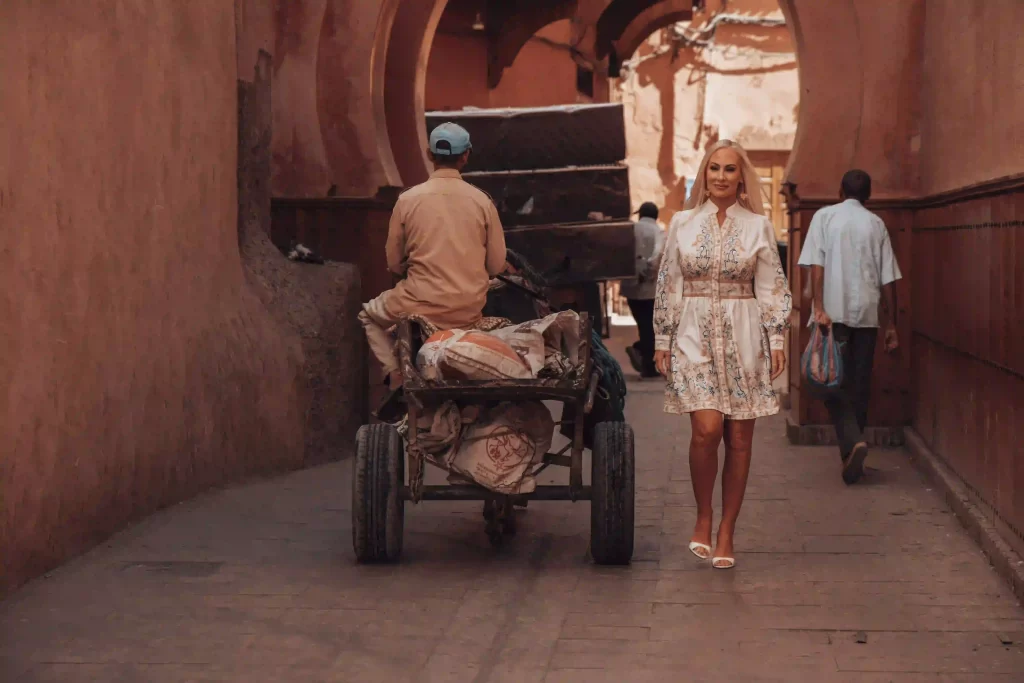

Day 3 : Marrakech to Essaouira
On Day 3 of our Moroccan vacation, we drove from Marrakech to Essaouira, a laid-back coastal city with beautiful landscapes. We journeyed from parched plains to the cooling Atlantic coast, leaving Marrakech’s bustling vitality behind. We arrived at Essaouira to a fresh sea wind and waves smashing on the coast. The defensive walls and medieval ramparts of this city evoke timelessness. The peaceful mood and tiny lanes of Essaouira’s medina, another UNESCO World Heritage site, contrast with Marrakech’s crowded one. We walked into Essaouira’s bustling fishing port, where local fisherman brought in their daily catch, crucial to the city’s economy and culture. Beautiful vistas and the city’s link to the sea were available at the harbor. Our tour to Essaouira’s medina included Portuguese, French, and Berber architecture. The medina is known for its expert woodworkers, especially those who use Thuya wood. Known for its art, the city hosts galleries and music events, notably the Gnaoua World Music Festival. This cultural atmosphere makes the city appealing to artists and musicians. The Atlantic Ocean sunset was the best way to conclude our day in Essaouira. We spent the night in one of Essaouira’s beautiful hotels, enjoying its tranquil beauty and cultural richness as a contrast to Marrakech’s bustling.


Day 4 : more time in Essaouira and drive to Agadir city via Argan forest
Day 4 of our Moroccan adventure started with extra morning leisure to enjoy Essaouira’s tranquility. This extra time enabled us to enjoy the city’s tranquility and see things we missed the day before. We might have strolled down Essaouira’s famous beach for windsurfing and kite surfing or shopped at the local shops for unique products and art. We drove across Morocco’s countryside to Agadir after enjoying Essaouira’s last moments. A highlight of our trip was traveling through the Argan forest. Moroccan Argan trees are crucial to the region’s natural and cultural history. Argan oil, a treasured element in cosmetic products and local cuisine, is traditionally produced here. We saw goats climbing Argan trees to eat its fruits during our journey through the woodland. We also visited local Argan oil cooperatives to learn about their traditional processes from the ladies who manage them. Learn about the manufacturing process and support local communities by buying their goods at these sites. We saw a distinct side of Moroccan life in Agadir, a sophisticated city with stunning beaches and a lively tourist scene. Moroccan perseverance and modernism are symbolized by Agadir, rebuilt after a 1960s earthquake. Its broad roads, contemporary hotels, and large sandy beaches contrast with Essaouira and Marrakech’s cultural and historical atmospheres. We spent the evening in Agadir, enjoying contemporary luxury and magnificent natural landscape with the Atlantic Ocean as a background.

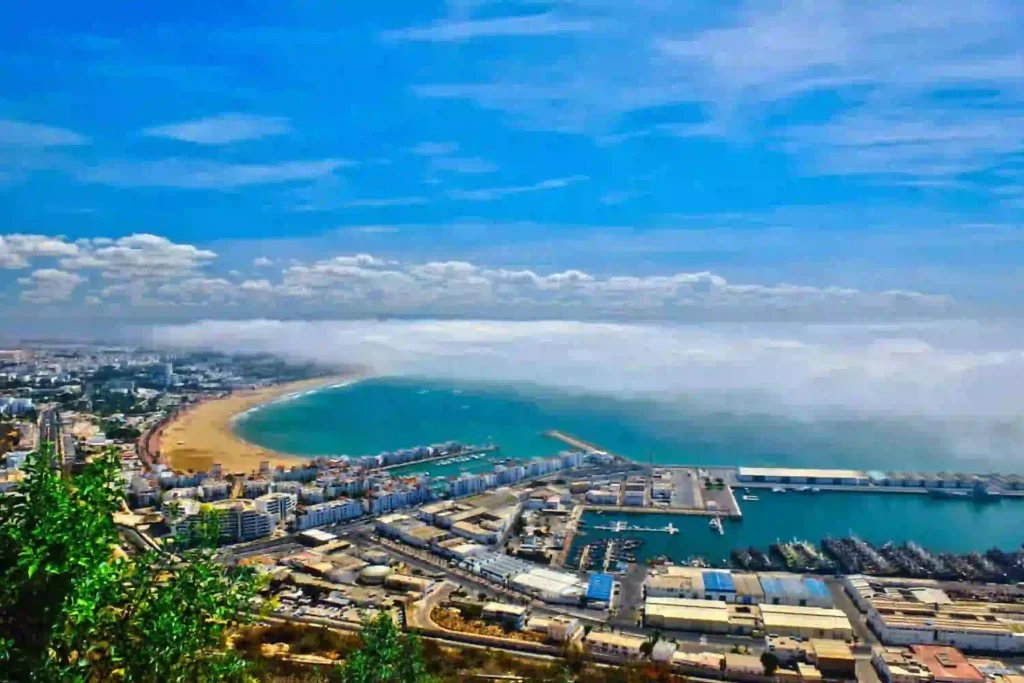
Day 5 : more time morning in Agadir and drive to Ouarzazate y ait BenHaddou Kasbah
A leisurely morning in Agadir marks the beginning of the fifth day of the program. This provides adequate time to explore the bustling city and the areas around it at a pace that is most comfortable for you. The adventure continues with a gorgeous drive to Ouarzazate, which comes after tourists have had the opportunity to enjoy the regional food and take in the breathtaking scenery of Agadir. By presenting Morocco’s varied landscapes and giving glimpses of the country’s rich cultural legacy, this route provides an experience that is both engaging and unforgettable. As soon as you arrive in Ouarzazate, which is well-known for its breathtaking kasbahs and serves as a gateway to the Sahara Desert, you will get the chance to see the well-known Ait Benhaddou Kasbah. This UNESCO World Heritage site is a remarkable example of earthen clay construction from Morocco, and it has used as the setting for a number of films. As a result of the fact that the day will include a combination of cultural immersion, beautiful drives, and leisure, it is going to be the highlight of the vacation.


Day 6 : Ouarzazate to Sahara Desert via Todra Valley
Beginning with a quick visit of Ouarzazate in the morning, the sixth day of the program provides a one-of-a-kind combination of cultural experiences and exciting adventures. Ouarzazate, sometimes referred to as the “Door of the Desert,” is a captivating city that has a plethora of cinematic history and breathtaking kasbahs, offering visitors a look into the architectural and cultural legacy of Morocco. Immediately after the investigation, the excursion will continue in the direction of the magnificent Sahara Desert, passing via the stunning Todra Valley along the way. This portion of the drive is a visual treat, boasting palm groves and canyons that are striking in their own right, highlighting the many landscapes that Morocco has to offer. The trip through Todra Valley is not only a voyage; rather, it is an experience in and of itself, providing opportunity to view the breathtaking natural beauty and maybe engage with the people that are located there. The day will come to a close when you arrive at a desert camp in the Sahara, where you will spend the night. The opportunity to spend a night in the desert is an experience that cannot be matched. It provides the opportunity to take in the sight of the night sky filled with stars, to indulge in traditional Moroccan food, and maybe even to take part in some of the local music and dancing, making it a portion of the voyage that will be remembered forever.


Day 7 : Full day exploration Sahara desert
Your seventh day is a cultural and ecological adventure in the Sahara Desert in Merzouga. To start the day, a deep dive into Erg Chebbi’s huge dunes, where the Sahara’s infinite golden scenery offers peace and awe-inspiring splendor. The adventure takes you to nomadic villages in this gorgeous desert. These excursions reveal the lifestyles of individuals who have adapted to the harsh desert climate. Discover their rituals, traditions, and intriguing way of living in such a harsh environment. Khamlia is a must-see for the day. This Gnaoua community is rich in culture. The Gnaoua, from sub-Saharan Africa, are known for their soulful music and rhythmic dances that reflect their history and culture. Experiencing their music is enjoyable and educational about a rich cultural legacy. Lunch will include Berber pizza, a local specialty. This supper at a local restaurant is a true sample of regional food, with tastes as diverse as the scenery. The Sahara’s Day 7 offers stunning scenery and rich culture. This day will enhance your Moroccan journey with the peaceful majesty of the dunes, the rhythmic rhythms of Gnaoua music, and the delicious native food.
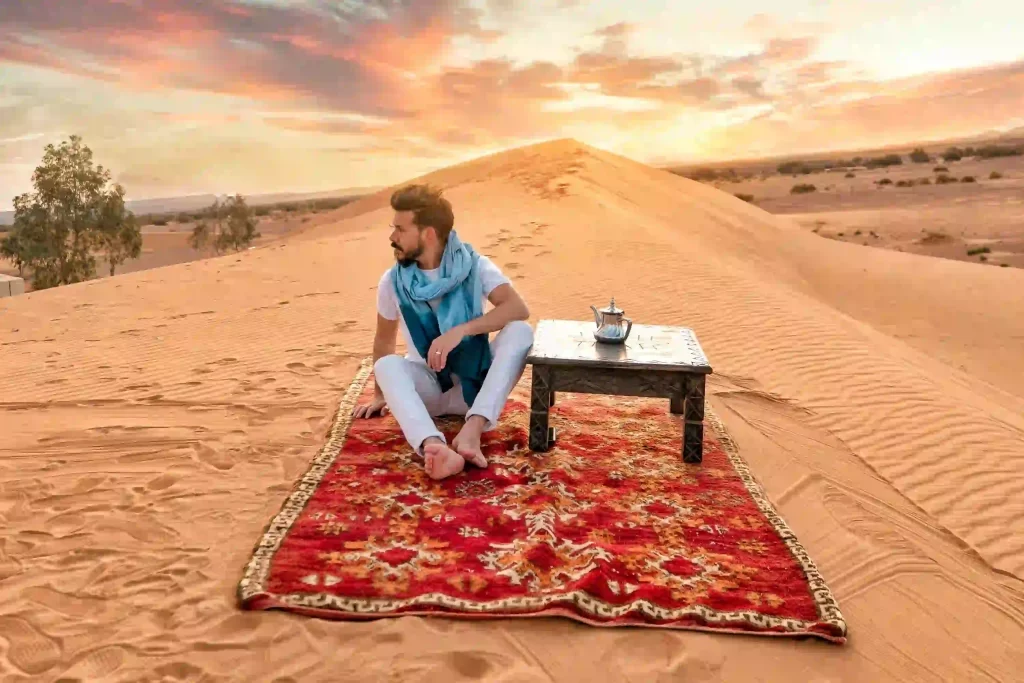
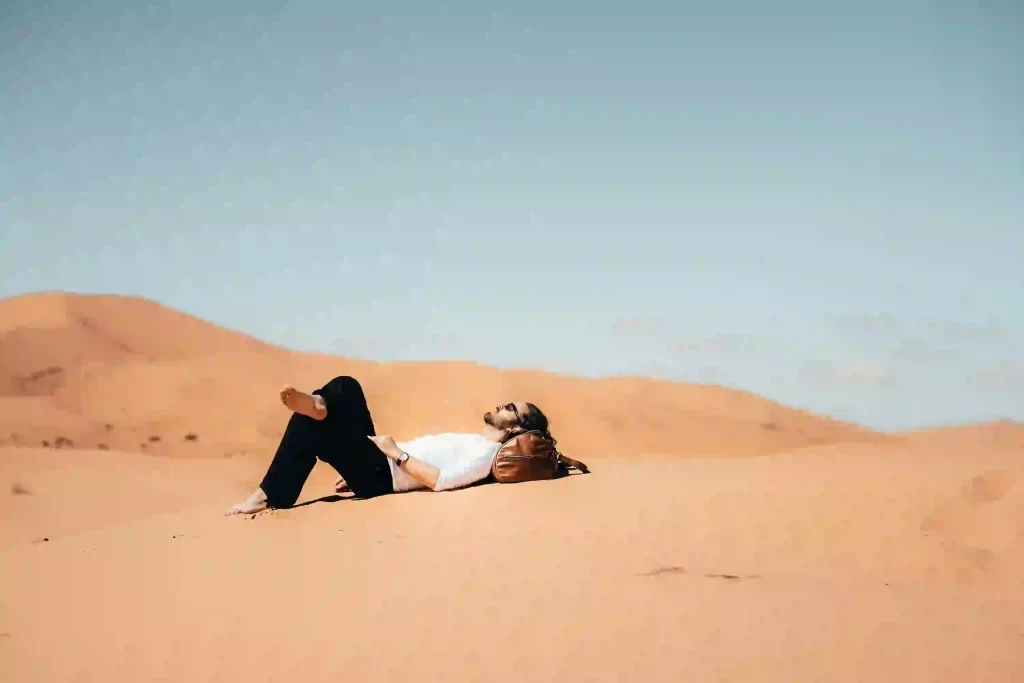
Day 8 : Sahara desert to Fes via Middle Atlas
Traveling from the Sahara Desert to Fes on Day 8 offers various scenery and cultural experiences. Start the day by departing Merzouga and the Sahara’s stunning dunes. Erfoud, the Sahara’s entrance and fossil-rich city, is your first stop. This is a rare chance to learn about the region’s geological history and visit fossil workshops to explore old riches in the rocks. Travel through the picturesque Ziz Valley from Erfoud. The vibrant date palm orchards along the Ziz river contrast with the arid environment in this region, noted for its lush oasis and dramatic scenery. The trip through this valley offers breathtaking vistas and an insight into rural Moroccan life. Lunch is in Midelt, a high plains town between the Middle and High Atlas Mountains. Enjoy traditional Moroccan food in this city to relax and experience the local culture. The Cedar Forest, home to Barbary macaques, is visited after lunch. This unusual woodland lets wildlife lovers observe these curious monkeys in their native surroundings, a great experience. Your next destination is Ifrane, known as the ‘Switzerland of Morocco’ for its alpine architecture and colder environment. This picturesque village contrasts with Morocco’s arid scenery, demonstrating its variety. Fes, one of Morocco’s cultural centers, concludes the day. Fes, with its old medina, antique architecture, and bustling cultural life, is a great end to a day of seeing Morocco’s most magnificent landscapes. The city’s rich history and culture will prepare you for your Moroccan trip.
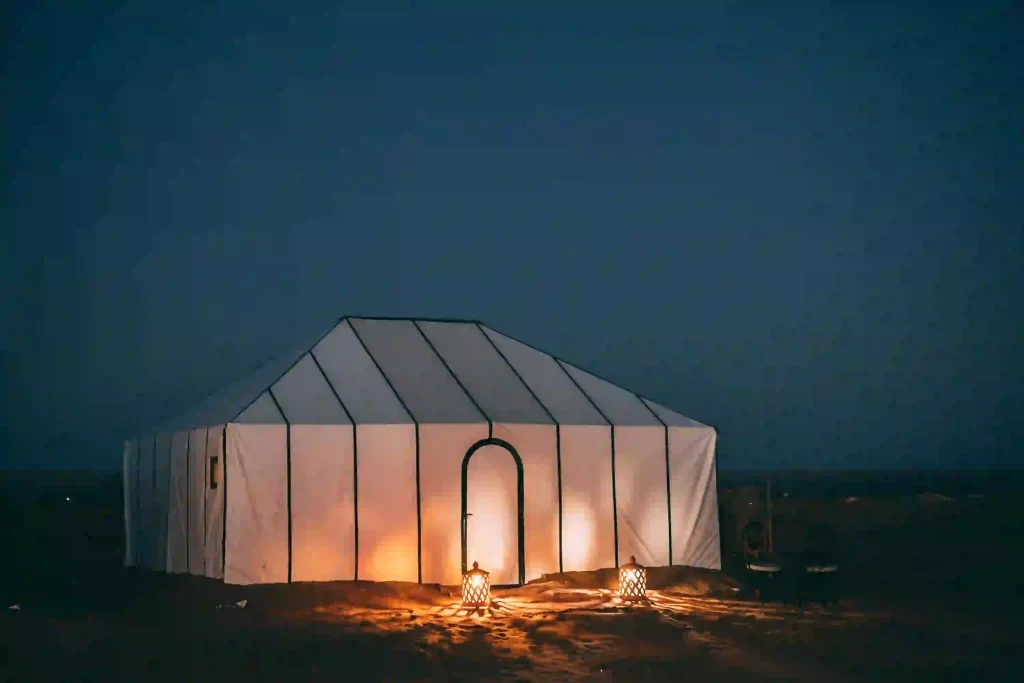

Day 9 : Full day exploration with Local guide
Day 9 takes you to Fes, one of Morocco’s most culturally and historically rich towns. This full-day trip with a local expert will explore the city’s rich historical and complex urban fabric. Moroccan culture is centered on Fes, known for its UNESCO World Heritage Site, Fes el-Bali. During your tour of the intricate alleyways, your guide will reveal medieval city secrets. In busy souks, artists offer leather products, sophisticated metalwork, fabrics, and pottery. Moroccan souks are living museums of traditional crafts as well as shopping centers. Highlights include visiting Al-Qarawiyyin institution, the world’s oldest continuously functioning institution. Its 9th-century founding shows the city’s long history of study and knowledge. Another important destination is the Chouara Tannery, which demonstrates traditional leather tanning and coloring techniques. Terraces provide a lovely, although fragrant, vista of the dye-filled stone containers. Your guide will show you Important architectural landmarks like Bou Inania Madrasa and Moulay Idriss II Zaouia. These locations showcase Fes’ exquisite Islamic architecture, with elaborate tile work, carved wood, and plasterwork. In a classic Moroccan riad, you may have lunch with Arab, Berber, and Mediterranean flavors. You’ll explore local culture and history by exploring hidden jewels and meeting artists throughout the day. The experienced instruction will help you appreciate this old city, making your day in Fes unforgettable.


Day 10 : Fes to Chefchaouen via Rif Mountains
On Day 10, you’ll travel from Fes to Chefchaouen, the Blue City, across the Rif Mountains. This journey will be as enthralling as the destination. Start your adventure from Fes to northern Morocco. The Rif Mountains, noted for their rugged beauty and distinct culture, are on the route. The trip across these mountains offers breathtaking views of lush slopes, medieval towns, and the Mediterranean Sea. Tourists seldom visit this section of Morocco, making it more peaceful and genuine. One of Morocco’s most attractive cities, Chefchaouen, awaits you. The centuries-old blue-painted homes and structures in Chefchaouen are renowned. The town’s blue tones against the green mountains are magnificent. Explore Chefchaouen at your leisure. Each bend in the medina’s tiny, cobblestone alleyways reveals a fresh hue of blue and a picture opportunity. The town’s laid-back vibe lets you enjoy its charm at your own speed, unlike bigger Moroccan cities. You may browse local stores for handicrafts, wool clothing, and handmade carpets or relax at one of the town’s cozy cafés with a Moroccan mint tea. Chefchaouen is a relaxing place to relax and reflect on your Moroccan experience, making this day a tranquil stop before your next excursion.


Day 11 : Driving from Chefchaouen to Casablanca via rabat city
The picturesque trip from Chefchaouen to Casablanca on Day 11 includes a stop in Rabat, Morocco’s capital. This tour combines ancient and current Moroccan experiences to illustrate its variety. The trip south from Chefchaouen’s peaceful, blue-washed streets to Morocco’s busy capital begins. After leaving the Rif Mountains, Morocco’s terrain changes, showcasing its richness. An important stop on this voyage is Rabat, a city that blends history and modernity. Rabat, Morocco’s political and administrative capital, is more laid-back than other big cities. Explore some of the city’s highlights here. The Kasbah of the Udayas, a UNESCO World Heritage Site with stunning Atlantic Ocean views, the Hassan Tower, an iconic minaret of an incomplete mosque, and the Mausoleum of Mohammed V, a modern Moroccan masterpiece honoring the king who led the country to independence, are highlights. After Rabat, travel to Casablanca, Morocco’s main city and commercial center. Rabat’s ancient appeal and Casablanca’s dynamic modernity reveal Morocco’s complexity. You’ll find a lively city with Art Deco architecture, contemporary projects, and historic attractions in Casablanca. The city is known for features like the Hassan II Mosque, one of the world’s biggest, with its stunning architecture and Atlantic Ocean view. Today ends in Casablanca, where you may spend the evening visiting the city’s restaurants and activities. The night in Casablanca lets you feel Morocco’s modern pulse after a day of history and urban exploration.


Day 12 : see Casablanca spots and departure flight
Day 12 includes touring in Casablanca, Morocco’s biggest city, then departure. Even with time limits, this day lets you feel Casablanca’s lively spirit. Visit Casablanca’s famous Hassan II Mosque to start your tour. One of the biggest mosques in the world, it overlooks the ocean and showcases Moroccan craftsmanship. Its elaborate tile, wood carving, and artistic detailing are stunning. The mosque may be available to non-Muslims for guided tours depending on your travel schedule. After seeing the mosque, go along the Atlantic Ocean Corniche. Cafes, restaurants, and pools flank this neighborhood, providing a relaxing setting for seaside views and breakfast or lunch. If time allows, go into Casablanca’s city center to see its distinctive mix of contemporary and Art Deco buildings. A fascinating new medina, the Habous Quarter, blends Moroccan and French colonial styles. It’s perfect for last-minute shopping, with local crafts and pastries. After your quick excursion, head to the airport for your journey. This concludes your Moroccan vacation, which included the peacefulness of the Sahara Desert, the cultural richness of Fes and Rabat, the distinctive appeal of Chefchaouen, and the bustling modernism of Casablanca. You leave with recollections of a place rich in history, culture, and nature.
